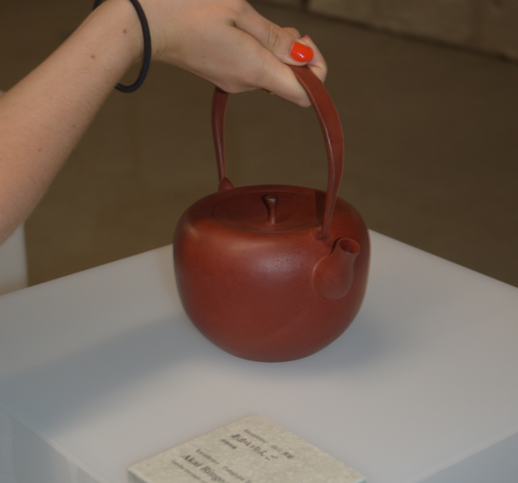2024.08.01
伝検通信(メルマガ)週刊メールマガジン「伝検通信」 第18号
週刊メールマガジン「伝検通信」第18号をお届けします。
今号のトップ記事は、三菱UFJフィナンシャル・グループ(MUFG)が伝統工芸産業振興のために米ニューヨークで開催したイベントのレポートです。
「クイズで肩慣らし」は前回クイズの答え・解説と、和紙・染織分野からの出題です。
メルマガ登録した方の中から、抽選で100人に公式テキストをプレゼントするキャンペーンも今月末まで引き続き実施中です! ぜひお近くの方にメルマガ登録をご案内ください。
伝検公式テキスト
https://bookpub.jiji.com/book/
目次
・ 三菱UFJ、伝統工芸の魅力発信―次世代へ継承、海外にも活路
・ 「クイズで肩慣らし」第18回(和紙・染織)=「線香花火」
・ 伝検協会だより
三菱UFJ、伝統工芸の魅力発信―次世代へ継承、海外にも活路

リンゴを模した南部鉄器の鉄瓶。注文から納品まで約9カ月待ちの人気の品。
三菱UFJフィナンシャル・グループ(MUFG)は、日本の伝統工芸品の魅力発信に注力している。深刻な後継者不足に直面する伝統工芸産業を盛り上げ、次世代への継承に一役買いたい考え。海外市場にも活路を見いだすため米ニューヨーク・マンハッタンで6月上旬に開いたイベントでは、後継者育成の視点や現代生活に即した実用性も重視した作品が並んだ。
◇生産額8割超減少
伝統的工芸品産業振興協会(東京)の調べによると、2020年度に伝統的工芸品の生産に携わる従業員数は5万4000人、生産額は870億円。いずれも1980年ごろと比べて8割超も減り、落ち込みに歯止めがかからない状況だ。産業構造の変化や、市中に安価な製品があふれていることなどが要因とみられる。
社会・経済環境の変化を背景に技術継承や一部原材料の確保なども難しくなる中、こうした事態に対策が打たれなければ、地方経済の活力が一段と失われる可能性がある。MUFGは社会貢献活動の一環として、文化の保全・伝承が重要と判断し、昨年8月にプロジェクトを立ち上げた。
プロジェクトは「時代に合った革新が無いと生き残っていけない」(担当者)との視点に立ち、伝統を重視しながらも日常生活への浸透なども意識した創作活動を後押しする。国内外での展示会や情報発信に加え、後継者育成を目的とした奨学金といった支援制度も検討。関係省庁や関連団体などと連携し、伝統工芸産業を応援する仕組みづくりを目指すとともに、全国各地の支店を通じた伝統工芸品の掘り起こしも進める。
◇新人も全工程学ぶ
6月にニューヨークで行われたイベントでは、岩手県の工芸品である南部鉄器や、京都府の西陣織を使ったクッション、おけを活用したワインクーラーなど計約20作品を展示した。
リンゴを模した南部鉄器の鉄瓶は、ごつごつした模様を施した従来のものと比べてシンプルなデザインが特徴だ。鉄瓶を手掛ける職人の田山貴紘さんは「家庭で使ったときになじみやすく、シンプルなデザインを好む消費者が多い」と説明。現在、注文から納品まで約9カ月待ちの状況という。
鉄瓶を手に取った来場者からは「完璧なデザインだ」「色合いがいい」といった感想が聞かれた。
南部鉄器の全工程を一人でこなすには、30年程度の修業が必要とされる。ただ、こうした慣習は「新たなチャレンジ」(田山さん)を阻害しかねないためデザインを簡素化し、1年目からすべての工程を学ぶ育成方法に変更した。技術を早く身に付けてもらうことで、後継者確保につなげる狙いもある。
MUFGが国外でイベントを開くのは昨年9月のフランス・パリに続き2回目。プロジェクトの総合監修を務める東京芸術大の秋元雄史名誉教授は「米国は良い物に敏感な人が多く、丁寧な作りの製品を評価する場所だ」と意義を強調した。伝統工芸が乗り越える課題として、「工程を複雑にする装飾技術が本当に必要かどうか疑い、どの部分を残すかという判断がリノベーションの上で重要だ」と指摘した。
▼時事通信社「金融財政(2024/06/24日号)」より
▼MUFG工芸プロジェクトのリンク
MUFG工芸プロジェクト 三菱UFJフィナンシャル・グループ
「クイズで肩慣らし」第18回(和紙・染織)=「線香花火」
~伝検公式テキスト(9月20日先行発売予定)のジャンルごとに出題します~

夏の風物詩 線香花火
第18回
問題:手持ち花火の代表格である線香花火。現在は、和紙で火薬を包んだものが一般的ですが、江戸時代に、ある細長いものの先に火薬をつけたものが始まりと言われています。その細長いものは何でしょう。
【前回の答えと解説】
問題:大正時代に始まったといわれる九谷焼の彩色技法の一つで、イッチンという特殊な道具・技法を使って丸い点を描く、写真に見られるような上絵の盛り上げ技法は何というでしょう。
答え:青粒(あおちぶ)
解説:九谷焼は地元石川県の方言で「あおちぶ」と呼ばれています。極小の点を密集させて描く上絵の盛り上げ技法の一つで、粒の大きさ、色、間隔を均一にするという緻密な技術が要求される技法です。青粒のほかに白粒(しろちぶ)や金粒(きんちぶ)などもあります。写真の器(クイズで肩慣らし参照)は九谷焼の伝統工芸士・仲田錦玉(なかた・きんぎょく)さんによるもの。極小の点描が等間隔で渦を巻くように描かれ、華やかに輝く金盛の文様との美しいバランスが特徴で、青粒技法の第一人者と言われています。
伝検協会だより
▼國學院大學(東京)の学生・職員のみなさんに伝検を紹介していただいています。伝検パンフレットを、渋谷キャンパスの掲示板に張り出してもらっているほか、同キャンパス内の國学院大学博物館に置いてもらっています。同大の担当者によると、神職の養成大学の一つとして神道文化学部があるだけに、「伝統文化に興味を持つ学生は多い」とのことです。伝検を通じて若い世代の方にも、もっと日本の伝統文化に関心を寄せていただき、世界を魅了する「日本の価値」を知ってもらいたいと思っています。
▼「庭園」も伝検の学習・出題範囲の一つですが、伝検協会の正会員であるジャパンタイムズが、先週発行した「Sustainable Japan Magazine」7月号で日本庭園の特集を組みました。米オレゴン州にあるポートランド日本庭園の文化・芸術・教育担当上席執行役員中西玲人さんのインタビューを基に、さまざまな角度からその魅力に迫っています。海外からの視点はとっても新鮮です。ぜひご一読ください。
日本語記事はこちら
<ポートランド日本庭園>から、日本庭園の魅力とは何かを考える。
https://sustainable.japantimes.com/jp/magazine/416
<ポートランド日本庭園>の文化・教育担当者が選ぶ日本で見るべき5つの庭園
https://sustainable.japantimes.com/jp/magazine/417
編集後記
伝検通信第18号はいかがでしたか。うだるような暑さが続きます。炎暑に外出すると、少し歩くだけで汗だくです。そのまま地下鉄に乗ったり建物に入ったりするとキンキンに冷えていて風邪を引きそうになります。日本は温帯気候と小学校で学びましたが、もう熱帯ではないかとすら思います。体調管理にどうか皆様お気を付けください。
カテゴリー: 伝検通信(メルマガ)





